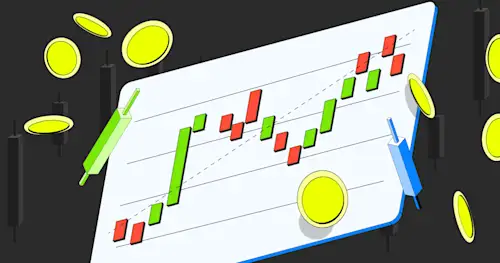Связанные статьи




Knowing the best time to buy or sell crypto is one of the toughest skills to master—even for experienced traders. While there’s no “holy grail” that guarantees profits, using the right crypto trading indicators can dramatically improve decision-making, risk management, and consistency.
In this guide, we’ll break down 7 essential crypto trading indicators trusted by successful traders worldwide. You’ll learn how each works, why it matters, and how to integrate them into your strategy. Whether you’re a beginner just learning crypto technical analysis or an advanced trader refining your edge, these indicators are key tools for navigating volatile markets.
Best for: Identifying overbought and oversold conditions.
How it works:
Bollinger Bands, developed by John Bollinger, consist of three lines:
A middle band (20-day simple moving average)
Two outer bands set two standard deviations above and below
When price touches the upper band, the asset may be overbought → possible pullback.
When price touches the lower band, the asset may be oversold → possible rebound.
Because the outer bands capture ~95% of price movement, prices tend to revert to the mean rather than break out.
Pro Tip: Combine Bollinger Bands with RSI for more reliable reversal signals.
Best for: Gauging overall market sentiment.
This index, created by Alternative.me, scores crypto sentiment on a 0–100 scale (0 = extreme fear, 100 = extreme greed). It’s based on:
Volatility
(25%) - past 30 and 90 days
Market momentum/volume
(25%)
Social media
(15%) - mentions on Twitter and Reddit
Surveys
(10%) - from crypto community members
Dominance
(10%) - Bitcoin market cap dominance
Trends
(10%) - from Google trends data
How traders use it:
Extreme fear → potential buying opportunity.
Extreme greed → potential market top.
Pro Tip: Use the index to confirm your technical analysis rather than as a standalone signal.
Deep dive: Crypto Fear and Greed Index Explained: How Traders Can Use It
Best for: Identifying support and resistance levels.
Derived from the Fibonacci sequence, common retracement levels include 23.6%, 38.2%, 61.8%, and 78.6%.
Traders apply these by selecting two price points (swing high + swing low). The levels in between often act as reaction points.
Pro Tip: Look for confluence—when Fibonacci aligns with historical support/resistance or moving averages, signals are stronger.
Full guide: What Are Fibonacci Levels in Crypto Trading? A Complete Guide to Using Fibonacci Retracement and Extensions
Best for: Spotting trend reversals and momentum shifts.
The MACD line = 12-day EMA − 26-day EMA The Signal line = 9-day EMA of the MACD line
The most common strategy is the MACD crossover:
MACD crosses above the Signal line: Bullish signal.
MACD crosses below the Signal line: Bearish signal.
Pro Tip: Use MACD alongside volume indicators to validate breakout strength.
Best for: Determining trend direction.
Moving Averages smooth out price action to help traders identify trends:
Simple Moving Average (SMA): Equal weight to all data points.
Exponential Moving Average (EMA): Gives more weight to recent data.
Typical signals:
Price above a rising MA = Uptrend
Price below a falling MA = Downtrend
Pro Tip: Watch for Golden Cross (50-day MA crosses above 200-day MA) and Death Cross (opposite) as long-term trend signals.
Best for: Identifying overbought/oversold conditions.
The RSI measures momentum on a scale of 0–100:
Above 70 = Overbought (potential pullback)
Below 30 = Oversold (potential rebound)
Pro Tip: Watch for RSI divergences (price makes new highs but RSI does not)—can signal potential reversals.
Guide: How to Use RSI in Crypto Trading: A Complete Tutorial
Best for: Spotting potential turning points.
The Stochastic Oscillator compares a crypto’s closing price to its price range over a set period, scaled between 0 and 100:
Above 80 = Overbought
Below 20 = Oversold
Pro Tip: Use Stochastic crossovers with trend direction for higher accuracy—buy oversold crossovers in uptrends, sell overbought crossovers in downtrends.
Avoid Indicator Overload: Too many tools can cause conflicting signals.
Combine Multiple Indicators: Pair trend, momentum, and sentiment tools for confirmation.
Build a Complete Strategy: Indicators work best with strong risk management.
Crypto trading indicators are not magic predictors—they are decision-making tools. The most successful traders combine indicators, apply them within a structured strategy, and manage risk with discipline.
By learning these 7 best crypto trading indicators, you’ll gain a solid foundation for technical analysis, improve your entries and exits, and trade with greater confidence in volatile markets.
Disclaimer: This material is for information purposes only and does not constitute financial advice. Flipster makes no recommendations or guarantees in respect of any digital asset, product, or service. Trading digital assets and digital asset derivatives comes with a significant risk of loss due to its high price volatility, and is not suitable for all investors. Please refer to our Terms.
The 4 Stages Of Crypto Market Cycle
Следующая статья7 Factors To Consider When Choosing A Crypto Trading Platform


